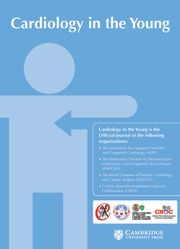No CrossRef data available.
Article contents
Patent ductus arteriosus rupture during percutaneous device closure: a case report
Published online by Cambridge University Press: 17 March 2025
Abstract
Patent ductus arteriosus is a common condition in preterm neonates, often necessitating medical or surgical intervention. This report presents a case of a preterm neonate born at 27 gestational weeks and who experienced patent ductus arteriosus rupture during a device closure procedure. Patent ductus arteriosus rupturing during device closure is rare and life threatening but can be successfully managed with prompt recognition and intervention.
- Type
- Brief Report
- Information
- Copyright
- © The Author(s), 2025. Published by Cambridge University Press
References
Hamrick, SEG, Sallmon, H, Rose, AT, et al. Patent ductus arteriosus of the preterm infant. Pediatrics 2020; 146: e20201209.CrossRefGoogle ScholarPubMed
Gillam-Krakauer, M, Reese, J. Diagnosis and management of patent ductus arteriosus. Neoreviews 2018; 19: e394–e402.CrossRefGoogle ScholarPubMed
Koch, J, Hensley, G, Roy, L, Brown, S, Ramaciotti, C, Rosenfeld, CR. Prevalence of spontaneous closure of the ductus arteriosus in neonates at a birth weight of 1000 grams or less. Pediatrics 2006; 117: 1113–1121.CrossRefGoogle ScholarPubMed
Rios, DR, Bhattacharya, S, Levy, PT, McNamara, PJ. Circulatory insufficiency and hypotension related to the ductus arteriosus in neonates. Front Pediatr 2018; 6: 62.CrossRefGoogle Scholar
Braulio, R, Gelape, CL, Araújo, FD, et al. Indicators of surgical treatment of patent ductus arteriosus in preterm neonates in the first week of life. Rev Bras Cir Cardiovasc 2013; 28: 504–508.CrossRefGoogle ScholarPubMed
Schneider, DJ, Moore, JW. Patent ductus arteriosus. Circulation 2006; 114: 1873–1882.CrossRefGoogle ScholarPubMed
Sathanandam, S, Gutfinger, D, Morray, B, et al. Consensus guidelines for the prevention and management of periprocedural complications of transcatheter patent ductus arteriosus closure with the amplatzer piccolo occluder in extremely low birth weight infants. Pediatr Cardiol 2021; 42: 1258–1274.CrossRefGoogle ScholarPubMed
Bixler, GM, Powers, GC, Clark, RH, Walker, MW, Tolia, VN. Changes in the diagnosis and management of patent ductus arteriosus from 2006 to 2015 in united states neonatal intensive care units. J Pediatr 2017; 189: 105–112.CrossRefGoogle ScholarPubMed
Sathanandam, SK, Gutfinger, D, O’Brien, L, et al. Amplatzer piccolo occluder clinical trial for percutaneous closure of the patent ductus arteriosus in patients ≥ 700g. Catheter Cardiovasc Interv 2020; 96: 1266–1276.CrossRefGoogle Scholar
Philip, R, Waller, BR, Agrawal, V, et al. Morphologic characterization of the patent ductus arteriosus in the premature infant and the choice of transcatheter occlusion device. Catheter Cardiovasc Interv 2016; 87: 310–317.CrossRefGoogle ScholarPubMed



